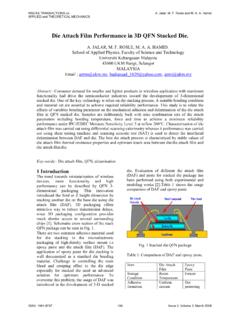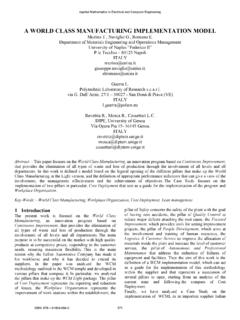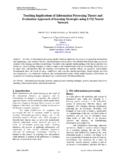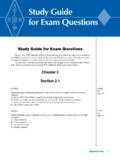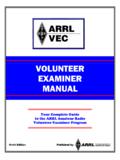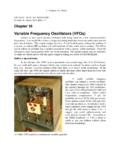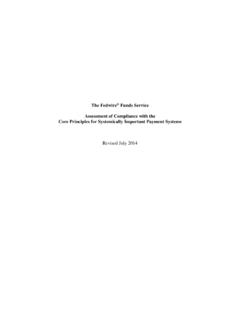Transcription of ARINC 629 Data Bus Standard on Aircrafts - WSEAS
1 ARINC 629 Data Bus Standard on Aircrafts YASEMIN ISIK Avionics Department Anadolu University Civil Aviation School, 26470, Eskisehir TURKEY Abstract In earlier analogue avionic systems the number of cables used to transfer information between the various system components was considerable. With these systems, at least one pair of wires has been required for each signal and so a typical installation requires several pairs of wires. With the equivalent digital systems, all the analogue signals are converted into their equivalent and are assigned unique address labels to ensure there are no conflicts. These signals are then transmitted down a single pair of wires, which makes up a data bus. Aircraft data bus systems allow a wide variety of avionics equipment to communicate with one another and exchange data.
2 The type of language used on an aircraft data bus is known as the protocol. There are currently different data bus standards (protocols) that currently account for most of the avionics data interchange on today s aircraft, and these are: ARINC 429, ARINC 629, MIL6 STD 1553, MIL6 STD 1773, CSDB and ASCB. In this study after evaluating the main characteristics of data transmission and data bus used aircraft systems, ARINC 629 Standard examined in detail. Key-Words: - Digital data transmission, Aircraft, Aircraft Data bus, Data bus standards, ARINC 629. 1 Introduction The form and interior configuration of Aircrafts are determined by aerodynamic and structural characteristics. Equipments (or devices) location therefore weights and dimensions depend on the interior configuration of aircraft.
3 However some of the equipments such as inertial navigation systems should be installed on some specific locations. This kind of restrictions can change options in device design. Such as devices or equipments can not be located in same place, have extensive cabling between each other. Also, some modernization programs cause some divisions in equipment locations. All these effects create groups of equipment communicate each other but different places [1]. On an aircraft, physical parameters (temperature, pressure, attitude information etc.) and data carried by electromagnetic waves are transmitted to related systems after converting electrical signals and processing. Electrical signals can be analogue or digital forms [2].
4 Data transmission methods had developed with the rapid development in technology and because of the increase in requirements electronic communication had begun to be insufficient. Using digital data transmission on Aircrafts is increased instead of analogue data transmission. In the literature there are severally some studies about data bus standards for civil and military aircraft. In this study after evaluating the main characteristics of data transmission and data bus used both civil and military aircraft systems, ARINC 629 (Aeronautical Radio Incorporated) data bus Standard examined in detail. 2 Data Bus Standards on Aircrafts Data transmission is the conveyance of any kind of information from one space to another.
5 Historically this could be done by courier, a chain of bonfires or semaphores, and later by Morse code over copper wires. In recent computer terms, it means sending a stream of bits or bytes from one location to another using any number of technologies, such as copper wire, optical fiber, laser, radio, or infra6red light [3]. In earlier analogue avionic systems the number of cables used to transfer information between the various system components was considerable. With these systems, at least one pair of wires has been required for each signal and so a typical installation requires several pairs of wires. With the equivalent digital systems, all the analogue signals are converted into their digital equivalent and are assigned unique address labels to ensure there are no conflicts.
6 These signals are then transmitted down a single pair of wires, which makes up a data bus. A bus is a collection of wires through which data is transmitted from one part of a computer to another. You can think of a bus as a highway on which data travels within a computer. When used in reference to personal computers, the term bus usually refers to internal bus. This is a bus that connects all the internal computer components to the CPU (Central Processing Unit) and main memory. However when used in reference to aircraft, it is the data highway which links Recent Researches in Circuits, Systems, Electronics, Control & Signal ProcessingISBN: 978-960-474-262-2191one computer to another within the aircraft, for example, the FMC (Flight Management Computer) and the ADC (Air Data Computer) [4,5].
7 Bus systems provide an efficient means of exchanging data between the diverse avionic systems found in a modern aircraft as shown in Figure 1 [6]. All buses consists of two parts an address bus and a data bus. The data bus transfers actual data whereas the address bus transfers information about where the data should go. On an aircraft bus, the two parts are incorporated within a single data word. A bus can be either serial or parallel. A serial bus requires less wiring, but is slower. A parallel bus required one wire for each bit within the data word, but is much faster. Aircraft bus systems use serial data transfer because it minimizes the size and weight of aircraft cabling.
8 With such a large number of avionic systems, a modern aircraft requires a considerable amount of cabling. Furthermore, some of the cabling runs in a large aircraft can be quite lengthy. Aircraft cabling amounts to a significant proportion of the unladen weight of an aircraft and so minimizing the amount of cabling and wiring present is an important consideration in the design of modern aircraft, both civil and military. A bus can enable communication between a single computer to a single LRU (Line Replaceable Unit) only, known as single source6single sink or a single computer to multiple LRUs, known as single source6multiple sink, or multiple computers to multiple LRUs known as multiple source multiple sink.
9 A data bus also classified on whether or not it can transmit in just one direction it is termed simplex. If it can transmit in both directions, but not at the same time it is termed half duplex. Where a data bus can transmit in both directions at the same time, it is termed full duplex. The type of language used on an aircraft data bus is known as the protocol. Main data bus standards that currently account for most of the avionics data interchange on today s aircraft, are ARINC 429, ARINC 629, CSDB (Commercial Serial Digital Bus), ASCB (Avionics Serial Communication Bus) and MIL6 STD 1553 (Military Standard ) [4,5,6]. Systems Data Buses Flight Control Data Buses Primary Flight Computers Autopilot Director Computers Air Data Rreference Unit Actuator Control Electronics Engine Data Interface Aircraft Information Management System Flap/Slat Electronics Unit Proximity Electronics Unit Multiple bus systems implemented on modern passenger aircraft Recent Researches in Circuits, Systems, Electronics, Control & Signal ProcessingISBN: 978-960-474-262-21923 ARINC 629 ARINC is a major company that develops and operates systems and services to ensure the efficiency, operation, and performance of the aviation and travel industries.
10 It was organized in 1929 by four major airlines to provide a single licensee and coordinator of radio communications outside the government [7]. It is now a large international company with headquarters in Annapolis, Maryland and over 50 operating locations worldwide. ARINC has two regional headquarters: London to serve the Europe, middle East, and Africa region and Singapore for the Asia Pacific region. The company has two major thrusts: Communications and information processing services for the aviation and travel industry. System engineering, development and integration for government and industry [4,8]. ARINC 629 was introduced in May 1995 and is currently used on the Boeing 777, Airbus A330 and A340 aircraft.

